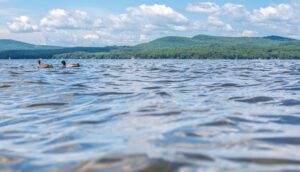Using paleolimnology and eDNA to assess links between warmer winters and summer blue-green algae in Maine lakes
Institution: University of Maine
Sponsor: Water Resources Research Institute National Competitive Grants Program (104g)

Project Summary
Blooms of cyanobacteria, or blue-green algae, are a growing problem in freshwater bodies across the United States, where they produce toxins that can cause illness in humans and other animals as well as environmental harm.
The ecological factors that promote the development of these harmful algal blooms (known as cyanoHABs) are poorly understood, and considerable uncertainty remains about how climate interacts with other drivers in determining the prevalence of cyanoHABs.
The main toxin of concern in the northeastern U.S., and in Maine, is microcystin-LR, which is produced by different groups of cyanobacteria found in lakes with low to high nutrient levels, indicating the widespread nature of this threat. The toxin is found in lakes across Maine.
A key question that this project will address is how warming winters may affect the increasing frequency of cyanoHABs in Maine’s lakes. This is a pressing question, as winter is the fastest changing season in Maine, with a rate of warming twice that of summer. All three of Maine’s climate divisions (Northern, Interior and Coastal) are warming more in winter than in summer, with the greatest change in the Coastal division.
Researchers will use paleolimnology, the study of lake sediments to reconstruct past environments, to determine how warmer winters over the past 125 years have affected the occurrence of toxin-producing cyanobacteria in Maine lakes. The research will leverage newly developed capacity in environmental DNA (eDNA), including sediment DNA (sedDNA), from the NSF-funded Maine EPSCoR RII Track 1 eDNA project. Members of the research team are also involved with the eDNA project.
Knowledge of whether cyanoHABs respond to warmer winters will help lake management agencies (federal, state, municipal and nonprofit) to better anticipate toxic blooms based on winter conditions and modify management plans as needed.
Project Update
This project is focused on investigating historical cyanobacterial abundances in 12 Maine lakes using lake sediment cores. During this reporting period, the team collected sediment cores and surface sediment samples from six (6) of the study lakes. This brings the total to eight (8) of the 12 lakes sampled; the remaining lakes will be cored this winter. The team collaborated with landowners for access to various lakes. Many of these cores have now been processed for dating and organic carbon analysis. Extensive work has also been done to freeze dry the sediments and extract photosynthetic pigments from them, in preparation for running them for pigment analysis using high-performance liquid chromatography. The team has also conducted preliminary environmental DNA analyses. For a small set of surface sediment samples, DNA has been extracted and quantified, and assays for two cyanobacterial taxa, Gloeotrichia and Cyanobium, have been conducted. These DNA analyses suggest that the team will be able to quantify the presence of key cyanobacterial taxa in the sediment cores.
Research Team:
- Team Leader: Jasmine Saros, associate director, Climate Change Institute; professor of paleolimnology and lake ecology, School of Biology and Ecology, UMaine
- Michael Kinnison, professor of evolutionary applications, School of Biology and Ecology, UMaine
- Charlie Culbertson, U.S. Geological Survey
- Peter Countway, Bigelow Laboratory for Ocean Sciences
- Denise Bruesewitz, Colby College
Project Partners:
- Maine Department of Environmental Protection (DEP)
- Lakes Environmental Association
- Portland Water District
Resources:
- UMaine News article (Oct. 27, 2020)
Products
Presentation – J.E. Saros. Using Paleolimnology and SedDNA to Evaluate the Links Between Warmer Winters and CyanoHABs in Maine Lakes. Joint Aquatic Sciences Meeting (JASM)
Presentation – Avery Lamb. Using Paleolimnological Tools to Evaluate the Links Between Climate Change and CyanoHABs in Maine Lakes. University of Maine Student Symposium. April 2022. Awarded Best Graduate Presentation in Natural Sciences
